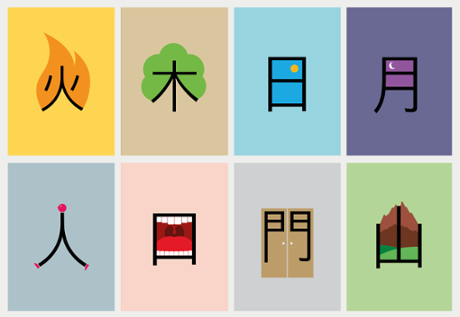
“Two's company, three's a crowd” may be a proverb for those scared of groups, but it's also a handy way of remembering your Chinese. The character for person looks a bit like someone walking in profile: 人. Take three of these, huddled in a little group, and you've got a crowd: 众
Such is the beautiful graphic logic revealed in a new book, Chineasy, which shines a spotlight of childlike clarity on the seemingly impenetrable world of Chinese ideograms. For anyone who's tried to learn Mandarin (and I am one of them), the painful hours of repeating stroke after stoke, until those tiny knots of random scratches are carved into your memory, can be enough to make you give up – particularly given the daunting fact that an average Chinese adult will have mastered around 5,000 such characters. Never mind the 50,000+ that await.
But in the hands of author ShaoLan Hsueh and graphic genius Noma Bar, the process is broken down into a visual story, depicting exactly why these mysterious bunches of lines are the way they are, and how they combine to form different words. It doesn't quite make Chinese easy, but the prospect of learning it has never been so visually appealing.
“It was all driven by a frustration that my kids just didn't have the patience to learn Chinese,” says Hsueh, the Taiwanese daughter of a calligrapher and a ceramicist, who struggled to keep the attention of her UK-born children with the usual language tapes, books and games. “I realised none of the teaching aids out there would work, so I decided to make one myself.”
With a background as a dotcom entrepreneur, she used a computer algorithm to break down thousands of characters into their constituent parts, in order to determine which were the most commonly recurring “building blocks”. These blocks, of which there are around 70 in the book, form the basis of the Chineasy method, each one beautifully illustrated in Bar's trademark style with bold colours and a simple economy of means, followed by an explanation of how they can be modified and combined to create new words.
Add a horizontal line to the character for person, like someone stretching their arms out wide, and you have the word for big: 大. A big person, 大 人, is an adult.
Or take a tree: 木. Two trees make a wood: 林. Three trees make a forest: 森. And of course a person leaning against a tree is having a rest: 休.
“By understanding the origins of the characters, which date back thousands of years, to cavemen scrawling on their walls and drawing lines in the dirt, you can learn a lot about the development of Chinese culture,” says Hsueh. “But it's not always a happy story.”
Characters involving women, in particular, reveal a lot about their secondary status in ancient China as possessions of their husbands (the word for madam is literally a man's person: 夫人), and as sources of both pleasure and aggravation. “The character for female (女) was originally a woman kneeling on the floor, showing obedience to her man,” says Hsueh. “Put two women together and you have an argument (奻), because with three or four generations living under one roof, the mother- and daughter-in-law would be bound to argue – along with the many wives and mistresses.” Three women, however, was thought a step too far, hence the character for adultery, three women piled up together: 姦. A good woman, meanwhile, was only one who bore a son, so the character for good is a woman and a boy: 好.
“One of my favourites is the traditional character for horse,” says Hsueh, pointing out how the ideogram features four little legs and what could be a tail dangling down at the end: 馬. “But it lost its legs under Mao.”
Chairman Mao may well have presided over a tyrannical period of forced labour, re-education and mass starvation, but surely he didn't go around chopping horses' legs off? Well actually he did, sort of, as far as characters are concerned at least. In the 1950s, as part of an ambitious plan to increase literacy rates among the vast rural population, the entire alphabet underwent a simplification – and in the process the horses legs became a single horizontal line: 马.
Ever keen to retain meanings, Hsueh always includes both the traditional and simplified forms in the book, as well as occasionally referring back to the ancient seal and clerical scripts, and the mysterious “oracle bones” script, originally drawn by shamans on fragments of shell and bone – dating back to the 14th century BC.
“A lot of the meaning has been lost in translation since then,” she says. “The character for 'to come', in traditional script, looks like two people inside a tree (來), but in fact it derives from the ancient character for wheat (麥), because wheat had been brought to China from Europe.”
In some cases the graphic clarity of the book belies such subtleties, although Hsueh is always at pains to clarify these hidden meanings in the accompanying notes. But some characters still remain utterly baffling. Take the compound form of flesh (月) and sunrise (日). Together they make 胆 – a fleshy sunrise? Actually, that makes gallbladder, which is also the character for courage, of which you will need a lot if you're ever going to master this language. Still, Chineasy – which will soon be available as an interactive app as well as a series of flashcards – is one of the least intimidating places to start.
• Chineasy: The New Way to Read Chinese by ShaoLan is published by Thames & Hudson. Buy it in the Guardian Bookshop for £10.36

